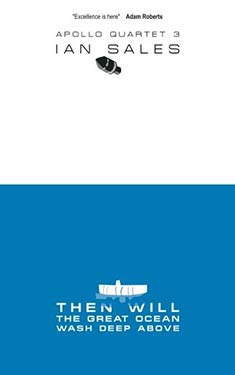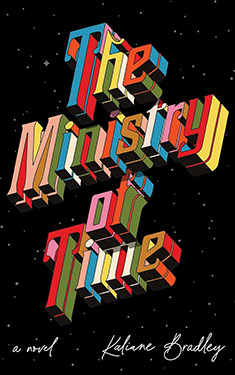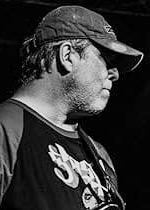
Added By: gallyangel
Last Updated: valashain
Then Will the Great Ocean Wash Deep Above
| Author: | Ian Sales |
| Publisher: |
Whippleshield Books, 2013 |
| Series: | Apollo Quartet: Book 3 |
|
1. Adrift on the Sea of Rains |
|
| Book Type: | Novella |
| Genre: | Science-Fiction |
| Sub-Genre Tags: | Hard SF Alternate History (SF) Alternate/Parallel Universe |
| Awards: | |
| Lists: | |
| Links: |
|
| Avg Member Rating: |
|
|
|
|
Synopsis
It is April 1962. The Korean War has escalated and the US is struggling to keep the Russians and Chinese north of the 38th parallel. All the men are away fighting, but that doesn't mean the Space Race is lost. NASA decides to look elsewhere for its astronauts: the thirteen women pilots who passed the same tests as the original male candidates. These are the Mercury 13: Jerrie Cobb, Janey Hart, Myrtle Cagle, Jerri Sloan, Jan Dietrich, Marion Dietrich, Bernice Steadman, Wally Funk, Sarah Gorelick, Gene Nora Stumbough, Jean Hixson, Rhea Hurrle and Irene Leverton. One of these women will be the first American in space. Another will be the first American to spacewalk. Perhaps one will even be the first human being to walk on the Moon. Beneath the surface of the Atlantic Ocean, deep in the Puerto Rico Trench north of San Juan, lies a film bucket from a KH-4 Corona spy satellite. It should have been caught in mid-air by a C-130 from the 6549th Test Group. That didn't happen. So the US Navy bathyscaphe Trieste II must descend twenty thousand feet to retrieve the bucket, down where light has never reached and the pressure is four tons per square inch. But there is more in the depths than anyone had expected, much more. This is not our world. But it very nearly was.
Excerpt
UP. It is April 1962. NASA arranges a press conference and gets the astronauts all gussied up and puts them on a stage behind a big table in a conference room in Dolley Madison House. There's maybe one hundred reporters in the room but not many men--and that includes the handful on the stage, like the NASA Administrator, Dr T Keith Glennan; and Dr W Randolph Lovelace and Brigadier General Donald D Flickinger, USAF, who started the whole thing when they put a group of women pilots through the astronaut tests.
The reporters ask lots of questions, about the selection process and the testing, and each of the thirteen gives the answers NASA has told them to give. Then a reporter sticks up her hand, Dr Glennan points at her and the reporter says, I would like to ask Mrs Hart if her husband has anything to say about this, and/or her eight children?
They are all as enthusiastic about the programme as I am, Janey Hart says; even the little ones.
How about the others? asks the reporter. Same question.
Suppose we go down the line, one, two, three, on that, says NASA Director of Public Relations Walter T Bonney. The question is: has your husband, or maybe he's just your beau, has he had anything to say about this?
Not all of the astronauts are married, not all of them are courting. When you log thousands of flying hours, there's not much room for cuddles and candle-lit dinners. Those who are married echo Hart's answer--everything back home is peachy, hubby backs her to the hilt, the kids think mom is great.
Geraldine Sloan, Jerri, the year before she was testing top secret terrain-following radar for Texas Instruments, flying B-25s a handful of feet above the waves over the Gulf of Mexico, she leans toward her microphone and says, I don't think any of us could really go on with something like this if we didn't have pretty good backing at home. If it is what I want to do, my husband is behind it, and the kids are too, one hundred percent.
A couple of eyebrows behind the table go up--they all know Sloan's marriage is pretty much over. If not for NASA public relations, Jerri and Lou would have gone their separate ways last year.
There is a shadow hanging over the conference though no one mentions it: the Russians have already put the first man into space, and followed him with a second; and it's going to be a while before the US can follow suit. NASA, however, will have the first woman in space, they're going to make sure of that--even though there are rumours coming out of the Soviet Union they're training a female cosmonaut, some parachutist, not a pilot.
Once the press conference is over, the "lady astronauts" file out and are bussed back to the hotel through the warm Washington air. Jerrie Cobb stares out the window of the coach and she's thinking about flying, about getting into the cockpit of one of those new supersonic jet fighters; while behind her she can hear one of the others wondering if they'll get to keep the Bergdorf Goodman suits they're wearing. They won't let Cobb near a jet fighter, of course; she has ten thousand hours in over two-dozen types of aircraft, but she's never flown a jet. Only men get to fly jets.
But pretty soon she'll be going higher and faster than any jet pilot.
A week later--they're still using Dolley Madison House, NASA headquarters, as a base of operations--Jackie Cochran joins them. NASA has signed her on as Head of the Astronaut Office, which means she's now in charge of them. Cobb is not happy, she doesn't trust Cochran, she has seen some of the letters Cochran wrote to the other women after they'd finished the first phase of the testing. Cochran's hints about "favouritism", her words that "one of the girls has an 'in' and expects to lead the pack", all the poisonous little turns of phrase Cochran used to present herself as the true leader of the "lady astronauts".
Now it is official.
Cobb knows she was not really the first, Ruth Rowland Nichols underwent some centrifuge and weightlessness testing at Wright-Patterson Air Force Base six months before Cobb was invited to the Lovelace Clinic; but Cobb, she was the real guinea pig, she was the first to complete all three phases of the testing, she was the subject of Dr Lovelace's talk at the Space and Naval Medicine Congress in Stockholm, she appeared in Life magazine.
And it was Cobb and Janey Hart who campaigned for NASA to push ahead with its Mercury programme using women. Cochran has always said, even when she ran the Women Airforce Service Pilots during the last war, she's always said the men go first and the women follow after and take up the slack. But there's no slack here now, all the men have gone out to Korea to fight the Soviets and the Chinese.
Cobb wants to go to Dr Glennan, but Hart argues against it. We were lucky, Hart tells Cobb, we were lucky the pilots they originally picked had to go back to active duty, we were lucky the other men NASA wanted are the kind that won't stay here but have to go off to fight in Korea. You know Jackie has been working to take over right from the start, well now she's done it.
Hart puts an arm around Cobb's shoulders. She drops her voice and adds, But Jerrie, Jackie is an old woman and not in good health. We're going into space, Jerrie. Jackie isn't.
Later, Cobb has to admit there are some advantages to having Cochran in charge. They all get to visit the White House when Cochran arranges a dinner with President Eisenhower and the members of the US Senate Committee on Astronautics and Air and Space Sciences. In evening gowns by Oleg Cassini and Norman Norell, accompanied by husbands or uniformed chaperones--Cobb finds herself on the arm of a young USAF first lieutenant from Texas called Alan Bean--they all sit down to a five-course dinner in the State Dining Room. Cochran and Eisenhower go back years, and every time someone asks a question of one of the astronauts, Cochran jumps in with an answer--and the president just nods and gives his sunny smile. Hart catches Cobb's eye and makes a face, but what can they do? The others, they're too excited about eating in the White House, about the photo session--Cochran has arranged an exclusive contract with Life magazine--before they were led into the State Dining Room. Cobb is thinking about spacecraft and wondering what the Earth will look like from one hundred miles up, and she wants to be the first woman on the planet to see that.
The next day, the astronauts--the press calls them the Mercury 13 now--fly down to Cape Canaveral for a guided tour, in a chartered Douglas DC-6 piloted by Cochran, although they could have all flown there themselves. From the airport they're bussed to the Holiday Inn in Cocoa Beach. That evening, as the sun sinks below the horizon, spraying red and orange across the palms and freeways, the women gather down by the pool, all except Cochran, and in the twilight they sip cocktails and chatter excitedly about the days ahead. It feels like some fevered dream, this group of well-dressed and well-spoken women with their martinis and manhattans and daiquiris, in the sharp heat of the lacquer-clear Florida night, and they're all thinking they're but a stone's throw from Cape Canaveral... A couple of days ago, sitting in a conference room, they were being presented to the world as pioneers, explorers of a new frontier, and they could feel on them the paternal gaze of the NASA meatball on the curtain behind the table. But this... this could be a meeting of the 99s. There's excitement in the voices but the laughter is brittle; the gestures are emphatic and the glasses are being drained faster than usual. Cobb watches the other women for a moment, then looks away. She's standing at the edge of the terrace, before her is the space-dark sea and the moon-bright sand, and she's barely touched the martini someone handed her.
There's a clatter of heels on the concrete, and Hart walks up and stands beside her.
We did it, Jerrie, Hart says. By God, we did it. We get to go way up there, where no man has gone before. Well, no American man anyway.
She flings up a hand, gesturing at the night sky and the stars sparkling like diamonds in it.
Cobb says nothing. When she sees a rocket launch, and a woman atop it, then she might start to relax. But not now, not yet.
Who will be first? she asks Hart. Who do you think?
You mean us or the Russian woman?
No, among us, out of the thirteen of us.
Hart shrugs and takes a sip of her martini. She plucks out the olive, eats it and then flicks the toothpick out onto the beach. You, she tells Cobb, you should be first, Jerrie. You did all this, you put us here.
They both know it's not so simple. Yes, Cobb first handed a list of candidates to Dr Lovelace; but Jackie Cochran put her own names in as well and she paid for all the medical testing, so there's some of the thirteen who think Cochran is the right woman to lead them. And now NASA has offically put her in charge. There's going to be a game of favourites in the weeks ahead, Cobb can see that.
You'll get to fly, Jerrie, Hart assures her. No matter what Jackie does or says, you'll get to fly.
DOWN. Lieutenant Commander John Grover McIntyre leans on the rail, draws on his cigarette, and gazes west toward Hispaniola. Ribbons of sunlight dance across the swell and the sky is heart-achingly blue, but he's thinking about being pulled from the Navy Experimental Diving Unit at the Washington Navy Yard. They flew him to Roosevelt Roads Naval Station, Puerto Rico, on a Grumman C-2 Greyhound, and then three hours cleaving the restless sea in a 65-foot utility boat out to the USS White Sands... and there in the ship's aft dock well is the white torpedo-shape of the Trieste II. As soon as he spots the bathyscaphe he knows what he's doing here 1,600 miles south of home.
He's going to the bottom of the Atlantic Ocean.
As near as he can figure it, they're some seventy-five miles north of San Juan, somewhere above the Puerto Rico Trench, and there's around 27,000 feet of water under the USS White Sands' keel. McIntyre is not happy. The Terni pressure-sphere is only rated to 20,000 feet and he's wondering if the guy running this operation knows that--
Which would be Commander Brad Mooney, commander of the Integral Operating Unit, and all he's told McIntyre is that the USNS De Steiguer found the target weeks ago after ten days steaming up and down the search zone, while the IOU was making test dives off San Diego; and they got to move fast as the deep ocean transponder batteries have a guaranteed life of only one month. No one's said what the "target" is yet, what it is McIntyre's supposed to be bringing up from the sea-bed. The Rube Goldberg contraption Perkin-Elmer have bolted to the front of the Trieste II--he's heard it called a "hay hook" and a "kludge"--looks like it might work, but McIntyre's sceptical, he knows the bathyscaphe; and for something that's as simple as a steel ball hung beneath a float filled with gasoline, she's temperamental and fragile and she knows how to make her commander's life hell. He thought he'd given her up back in 1967, when he transferred out to NEDU but here he is again, two years later, flown in because the bathyscaphe's current commander busted a leg on the journey bringing Trieste II from San Diego to Puerto Rico. So he guesses she's not ready to say goodbye just yet.
McIntyre was all over the bathyscaphe the day before, reminding himself of her systems and workings, and she looks pretty goddamn shipshape, but they need to get her out into the water. They've got a week of fine weather forecast and maybe it will hold. McIntyre holds out a hand and feels the sun beating down on his palm; and there's not a breath of wind, the sea surface is a gelid swell lapping noisily against the hull of the auxiliary repair dock.
Earlier, he spotted a pair of suits lurking about, so he's guessing this is some CIA operation. Maybe the flyboys went and lost another H-bomb, a "Broken Arrow" type thing; or perhaps a Soviet sub sank here, one of their nuclear attack ones, a "Victor". Cuba is only five hundred miles north east, and McIntyre is reminded of October 1962...
He flicks his cigarette out into the sea, checks the Omega Seamaster on his wrist, and then settles his cap more firmly on his head. This is where he gets to learn what he's diving for: the suits have scheduled a briefing. He's looking forward to it, he likes the idea of pulling the CIA's nuts out of the fire.
There's six of them gathered in the ward room, it's hot and the two open scuttles are doing nothing to stir the still air. The two spooks have ditched their jackets and their white shirts don't look so starched now. One has loosened his tie, the other slips off his spectacles every few minutes and polishes them with a handkerchief. Both have buff folders on the table before them. McIntyre and the two bathyscaphe crew, Lieutenants Phil C Stryker and Richard H Taylor, take seats alongside Mooney, across from the CIA guys.
What do you know about spy satellites? the one with glasses asks.
Nothing, says McIntyre. They're secret, right?
The spook gives an unamused smile. The KH-4B Corona, he says, is what we use to keep an eye on the bad guys, on the things they don't want us to see and we don't want them to know we can see. Let's just say you don't need to know more than that.
He pulls a piece of paper from his folder and slides it across the table. This, he tells them, shows how we get the film down from orbit.
The piece of paper is a diagram in colour: a rocket above the earth, a line of capsules falling from it in an arc and sprouting a parachute, while beneath waits a plane trailing a hook.
We send out a C-130 from the 6549th Test Group out of Hickam AFB and they catch the bucket, says the guy with glasses.
You lost one of them buckets, says McIntyre.
The other spook nods. We think maybe a malfunction kicked it out early, he says. We didn't get a plane in the air in time.
From Hickam? McIntyre asks. Hawaii, right? Dropping it in the Atlantic instead of the Pacific is some malfunction. So now it's below us? In the Puerto Rico Trench? You know that's 27,000 feet deep, right? The Trieste can only dive to 20,000 feet. We go any deeper than that-- He forms a sphere with two cupped hands and then suddenly, and loudly, claps his palms together: crack!-- Deeper than 20,000 feet and we go like that.
The guy with the tie at half-mast answers, It's on a shelf about 19,500 feet down, it's pretty flat and level--
He opens his folder and pulls out half a dozen black and white photographs. The USNS De Steiguer took these, he says, with the camera on the search fish.
He slides the photographs across to McIntyre, who fans them out across the tabletop. The bucket is a circular metal structure, surrounded by a halo of debris. To the right, a light on a cable illuminates the object and throws a pencil line of shadow off the left edge of the picture. The sea-bed looks flat and smooth, like a powdery desert.
It's intact? McIntyre asks.
We think so, the spook says. It hit the sea at a pretty good clip but we think it held together.
And that contraption you've bolted on the front of the Trieste, that's supposed to just scoop up this bucket from the sea-bed? McIntyre asks.
Mooney speaks up: You're in on this late, John. Phil and Dick already ran a bunch of test dives back in San Diego. The hay hook works.
The other spook adds, The USNS De Steiguer dropped a transponder about eight feet from the bucket so it should be easy to find.
McIntyre is not convinced: there's no light down there thousands of feet below the surface, only what the bathyscaphe carries--and her search lights don't illuminate much. He remembers previous dives, sitting in that cold steel ball and looking out at a blurred and ghostly landscape which seemed to stretch only yards in each direction before darkness took over, before reality ran out of substance...
And every time, he felt like an astronaut peering out at that grey sand, gazing out at a world which would kill him in a heartbeat.
Copyright © 2013 by Ian Sales
Reviews
Images
No alternate cover images currently exist for this novel.



















 Full Details
Full Details





